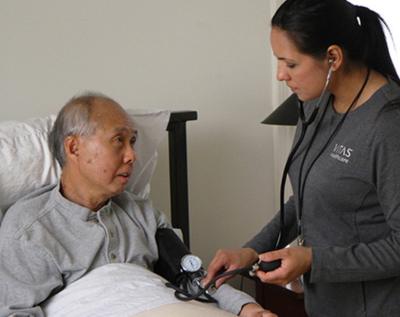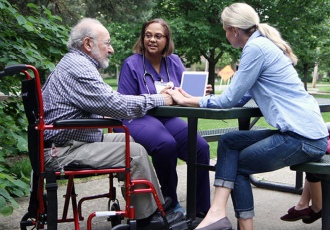By Aaron Ismaili, MD, Regional Medical Director, VITAS Healthcare
The natural history of many illnesses results in the development of physical and psychological symptoms, with pain often occurring the most commonly as end of life approaches.
A complex, feared, and often undertreated symptom, pain can diminish quality of life, cause undue stress, and affect day-to-day activities. Pain is a serious issue for as much as 40% of the population1, and about 25% of the elderly do not receive adequate analgesia.
For healthcare professionals caring for patients nearing end of life, understanding the multifaceted nature of pain management, as well as a thorough assessment of the burden and benefits of each medication, is integral to providing comfort when patients need it most.
A Diverse Multimodal Approach
Appropriate pain management is an important component of the care plan for patients with life-limiting illnesses. As pain is not a monolithic entity but rather a complex syndrome that differs with every patient that experiences it, it requires a diverse, multimodal approach, one that hospice can provide.
A wide variety of services must be provided to ensure appropriate pain management. To this end, VITAS offers the following:
- Thorough pain assessments at each visit
- Adjustments of medication and dosages based on a patient’s pain level
- Pain experts who choose the most appropriate, least invasive route toward relief
- Training for patients, family members, and caregivers on the administration of pain medications
- Information about a patient’s disease process and its signs of progression
- Breathing and relaxation techniques to help patients cope with symptoms
- Massage, music therapy, and other integrative services, as available
- Around-the-clock access to clinical teams
- Training for clinical staff and patient caregivers to recognize and address side effects of pain medication
The pain management process requires physicians to remain cognizant of the goals of care as determined through open communication with the patient and family, while recommending the most effective and appropriate medications and therapies needed to mitigate the pain.
A Person-Centered Team Effort
Teamwork is vital for effective pain management. As the nature of pain extends beyond the physical and encompasses the psychological, social, and spiritual domains, pain management must address all of these needs. This complex task requires a team effort.
With the multifaceted nature of pain in mind, hospice team members partner with the patient’s primary care clinicians to address symptoms such as pain.
At VITAS, our pharmacotherapy approach leverages the diverse skill sets of an interdisciplinary team to help manage patients with complex needs. Hospice teams comprise:
- Physicians who work with the patient, caregiver, and primary care clinician to address symptoms such as pain
- Registered nurses who are skilled in caregiver education and managing pain and other symptoms
- Social workers who provide emotional support and help with financial concerns and planning
- Hospice aides who provide personal care (bathing, dressing, feeding, etc.) based on each patient’s plan of care
- Chaplains who work with the patient’s own clergy and offer spiritual support
- Volunteers trained by VITAS to provide companionship, pampering, life enrichment, and respite relief for caregivers
- Bereavement specialists who offer grief and loss support and help with memorial services and other care for loved ones
Together, these team members all work towards the same goal: to effectively manage a patient's pain and other symptoms and to prevent further suffering, while maximizing quality of life in keeping with the patient's and family's wishes regarding goals of care.
VITAS hospice team members work with patients in their preferred setting of care; at home, in one of our dedicated inpatient hospice units, in a hospital, nursing home, assisted living community, or other residential care facility.
If your patient with advanced illness is experiencing pain, find out if they may be hospice eligible by using our interactive Palliative Performance Scale.
1Zelaya, et al. (2020), Chronic Pain and High-Impact Chronic Pain Among U.S. Adults, 2016. NCHS Data Brief No. 390. Available at https://www.cdc.gov/mmwr/volumes/67/wr/mm6736a2.htm


